现在分词作状语练习-含答案
- 格式:doc
- 大小:21.50 KB
- 文档页数:3

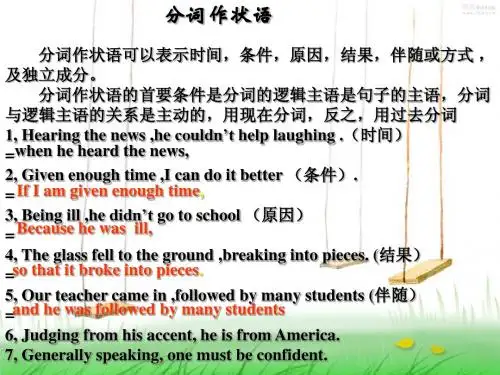
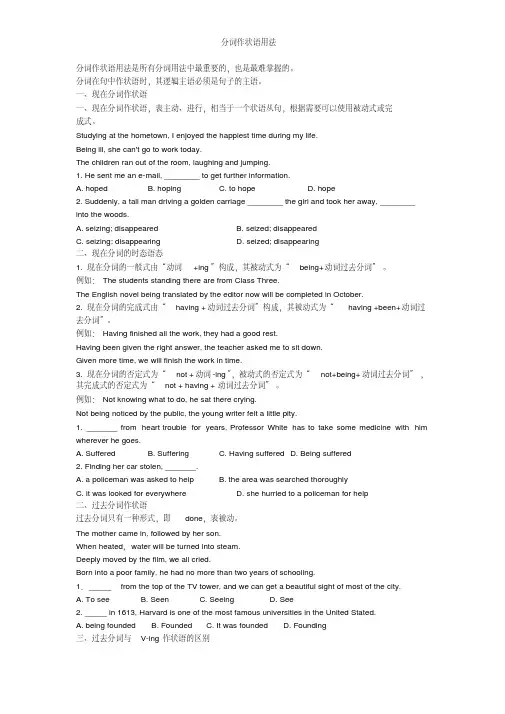

2019-2020年高中人教版英语必修四教学案:Unit 4 Section Ⅲ Grammar—现在分词作状语(含答案)语法图解探究发现①... I saw several young people enter the waiting area looking around curiously.②I stood for a minute watching them and then went to greet them.③She stepped back appearing surprised ...④Then Akira Nagata from Japan came in smiling, together with George Cook from Canada.⑤When Darlene Coulon from France came dashing through the door ...⑥Turning around, she saw an ambulance driving away.⑦The old scientist died all of a sudden, leaving the project unfinished.⑧Hearing the news, they jumped for joy.⑨Having smoked too much, he has suffered from lung cancer.[我的发现](1)黑体部分在句中作伴随状语的是①②③④⑤;作时间状语的是⑥;作结果状语的是⑦;作原因状语的是⑧⑨。
(2)比较句⑧和⑨可知:句⑧中动词-ing形式短语为一般式,表示动作与谓语动词同时发生;句⑨中动词-ing形式短语为完成式,表示动作发生在谓语动词之前。
(3)观察句①~⑨可知现在分词的逻辑主语都是句子的主语。
一、现在分词作状语的用法现在分词(短语)在句中作状语来修饰谓语动词或整个句子,表示动作发生的时间、原因、条件、结果、方式、让步或伴随状况。

初三英语分词作状语单选题30 题1. Seeing the teacher coming, the students stopped talking immediately.A. SeenB. SeeingC. To seeD. See答案解析:B。
本题中“Seeing the teacher coming”是现在分词短语作时间状语,表示“看到老师走过来的时候”。
现在分词表示主动和进行,学生主动看到老师走过来,所以用seeing。
A 选项seen 是过去分词,表示被动,这里学生不是被看到;C 选项to see 表目的,不符合语境;D 选项see 是动词原形,不能作状语。
2. Hearing the good news, he jumped with joy.A. HeardB. HearingC. To hearD. Hear答案解析:B。
“Hearing the good news”是现在分词短语作时间状语,表示“听到这个好消息的时候”。
现在分词hearing 表示主动和进行,he 主动听到好消息,所以用hearing。
A 选项heard 是过去分词,表示被动,不符合;C 选项to hear 表目的,不合适;D 选项hear 是动词原形,不能作状语。
3. Walking in the park, she saw many beautiful flowers.A. WalkedB. WalkingC. To walkD. Walk答案解析:B。
“Walking in the park”是现在分词短语作时间状语,表示“在公园里散步的时候”。
现在分词walking 表示主动和进行,she 主动在公园散步,所以用walking。
A 选项walked 是过去分词,表示被动,不恰当;C 选项to walk 表目的,不符;D 选项walk 是动词原形,不能作状语。
4. Looking out of the window, I saw a bird flying in the sky.A. LookedB. LookingC. To lookD. Look答案解析:B。
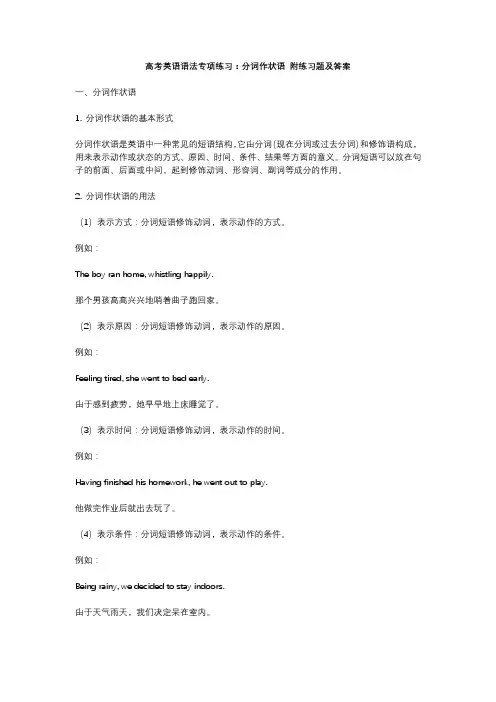
高考英语语法专项练习:分词作状语附练习题及答案一、分词作状语1. 分词作状语的基本形式分词作状语是英语中一种常见的短语结构,它由分词(现在分词或过去分词)和修饰语构成,用来表示动作或状态的方式、原因、时间、条件、结果等方面的意义。
分词短语可以放在句子的前面、后面或中间,起到修饰动词、形容词、副词等成分的作用。
2. 分词作状语的用法(1)表示方式:分词短语修饰动词,表示动作的方式。
例如:The boy ran home, whistling happily.那个男孩高高兴兴地哨着曲子跑回家。
(2)表示原因:分词短语修饰动词,表示动作的原因。
例如:Feeling tired, she went to bed early.由于感到疲劳,她早早地上床睡觉了。
(3)表示时间:分词短语修饰动词,表示动作的时间。
例如:Having finished his homework, he went out to play.他做完作业后就出去玩了。
(4)表示条件:分词短语修饰动词,表示动作的条件。
例如:Being rainy, we decided to stay indoors.由于天气雨天,我们决定呆在室内。
(5)表示结果:分词短语修饰动词,表示动作的结果。
例如:The boy fell off his bike, hurting his knee.那个男孩从自行车上摔下来,伤了膝盖。
3. 分词作状语的构成(1)现在分词作状语通常用来表示动作进行的方式、原因、时间、条件等,常常放在谓语动词之后,或者放在句首,用逗号与句子分开。
例如:He walked down the street, whistling a tune.他哼着曲子沿街走去。
Whistling a tune, he walked down the street.哼着曲子,他沿街走去。
(2)过去分词作状语通常用来表示动作已经完成或者被完成的情况,常常放在谓语动词之后,或者放在句首,用逗号与句子分开。
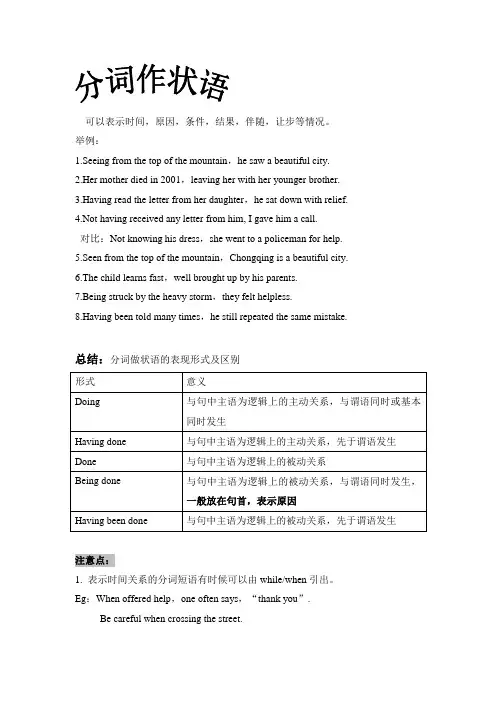
可以表示时间,原因,条件,结果,伴随,让步等情况。
举例:1.Seeing from the top of the mountain,he saw a beautiful city.2.Her mother died in 2001,leaving her with her younger brother.3.Having read the letter from her daughter,he sat down with relief.4.Not having received any letter from him, I gave him a call.对比:Not knowing his dress,she went to a policeman for help.5.Seen from the top of the mountain,Chongqing is a beautiful city.6.The child learns fast,well brought up by his parents.7.Being struck by the heavy storm,they felt helpless.8.Having been told many times,he still repeated the same mistake. 总结:分词做状语的表现形式及区别注意点:1. 表示时间关系的分词短语有时候可以由while/when引出。
Eg:When offered help,one often says,“thank you”.Be careful when crossing the street.2.有些分词货不定式短语作状语,其形式不受上下文限制,我们称其为独立成分。
常见的有:Generally/frankly speaking;Judging from/by;Considering/ taking .....into consideration;To tell you the truth;Seeing....考虑到;Supposing....假如,如果;Provided (that)....如果;3.独立主格的问题。
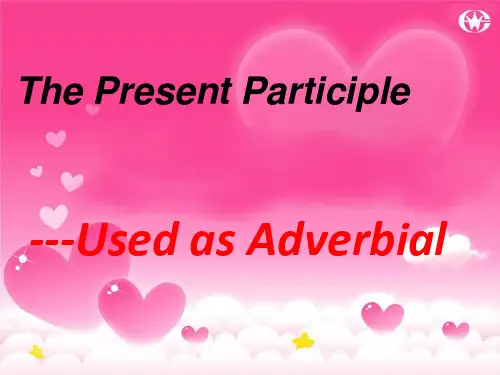

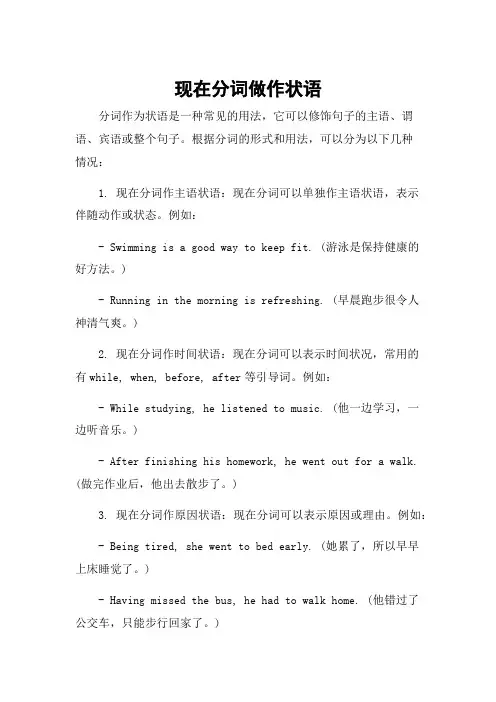
现在分词做作状语分词作为状语是一种常见的用法,它可以修饰句子的主语、谓语、宾语或整个句子。
根据分词的形式和用法,可以分为以下几种情况:1. 现在分词作主语状语:现在分词可以单独作主语状语,表示伴随动作或状态。
例如:- Swimming is a good way to keep fit. (游泳是保持健康的好方法。
)- Running in the morning is refreshing. (早晨跑步很令人神清气爽。
)2. 现在分词作时间状语:现在分词可以表示时间状况,常用的有while, when, before, after等引导词。
例如:- While studying, he listened to music. (他一边学习,一边听音乐。
)- After finishing his homework, he went out for a walk. (做完作业后,他出去散步了。
)3. 现在分词作原因状语:现在分词可以表示原因或理由。
例如:- Being tired, she went to bed early. (她累了,所以早早上床睡觉了。
)- Having missed the bus, he had to walk home. (他错过了公交车,只能步行回家了。
)4. 现在分词作结果状语:现在分词可以表示结果,常用的情况有so, therefore等引导词。
例如:- He studied hard so as to pass the exam. (他努力学习,以便通过考试。
)- The weather was bad, so they stayed at home. (天气不好,所以他们呆在家里。
)。
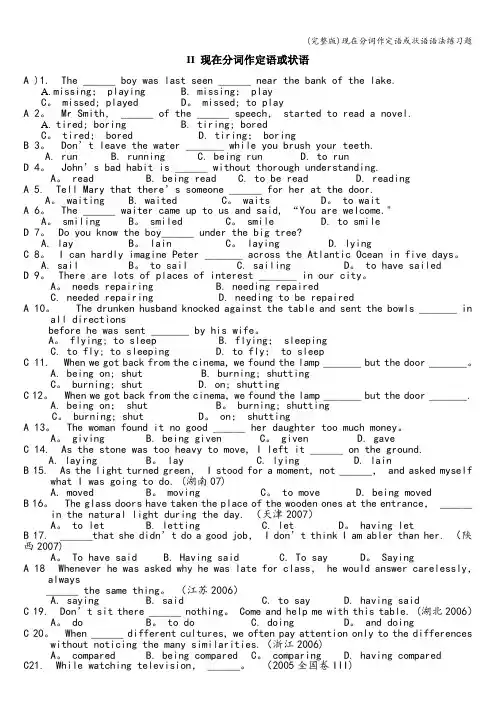
II 现在分词作定语或状语A )1. The ______ boy was last seen ______ near the bank of the lake.A.missing; playingB. missing; playC。
missed; played D。
missed; to playA 2。
Mr Smith, ______ of the ______ speech, started to read a novel.A.tired; boringB. tiring; boredC。
tired; bored D. tiring; boringB 3。
Don’t leave the water _______ while you brush your teeth.A. runB. runningC. being runD. to runD 4。
John’s bad habit is ______ without thorough understanding.A。
read B. being read C. to be read D. readingA 5. Tell Mary that there’s someone ______ for her at the door.A。
waiting B. waited C。
waits D。
to waitA 6。
The ______ waiter came up to us and said, “You are welco me."A。
smiling B。
smiled C。
smile D. to smileD 7。
Do you know the boy______ under the big tree?A. lay B。
lain C。
laying D. lyingC 8。
I can hardly imagine Peter _______ across the Atlantic Ocean in five days。
初二英语现在分词作状语完形填空题30题答案解析版1On a sunny Sunday, I went to the park. The park was full of people. Some were playing games, others were having picnics. I walked along the path, enjoying the beautiful scenery. Suddenly, I saw a little girl crying. I went up to her and asked what was wrong. She said she had lost her doll. I helped her look for the doll. While looking for the doll, I noticed a boy ___ kicking a ball. He seemed to be having a great time. After a while, we found the doll. The little girl was very happy. She thanked me and ran off to play.I continued my walk, feeling happy myself.1. The boy was ___ kicking a ball.A. happilyB. sadC. angryD. excitedly答案:A。
“happily kicking a ball”表示“开心地踢球”,用副词happily 修饰现在分词kicking,表示动作的伴随状态。
B 选项sad 和C 选项angry 与踢足球的场景不符;D 选项excitedly 也可以修饰kicking,但在这个语境中,happily 更合适。
分词作状语、分词作定语-配套练习1. The wild flowers looked like a soft orange blanket________ the desert.A. coveringB. coveredC. coverD. to cover解析:选A.句意为:野花好似一张柔软的桔色毯子,覆盖了沙漠。
这里句子已经有谓语动词looked like,所以空格处必须用非谓语动词,又因为blanket与cover之间是主动关系,现在分词表主动,故选A。
2. He dropped the glass, _____ it into pieces.A. breakingB. to breakC. brokenD. being broken解析:选A.句意为:他把杯子掉了,结果摔得粉碎。
这里句子已经有谓语动词dropped,所以空格处必须用非谓语动词,又因为he与break之间是主动关系,现在分词表主动。
所以答案是A。
3. He sent me an E-mail, _____ to get further information.A. hopedB. hopingC. to hopeD. hope解析:选B. 句意为:他给我发了一封电子邮件,希望能得到进一步的信息。
本题考查分词作状语。
本题的动词hop与句子主语he之间构成主动关系故使用现在分词的形式。
答案是B。
4. _____ alone in the large house, the little boy had to learn to survive by himself.A. To leaveB. LeavingC. LeftD. Being left解析:选A. 句意为:被独自一人留在这所大房子里面,这个小男孩不得不学会靠自己生活。
现在分词表示正在进行的伴随性动作,和句子主语是主谓关系。
结合语境可知小男孩是被遗留的对象,故用被动语态的现在分词,选D。
初二英语现在分词作状语单选题30题及答案1.______ doing his homework, Tom heard a strange noise.A.WhileB.WhenC.AsD.Since答案:A。
解析:while 后面可以接现在分词短语,表示“在……的时候”,强调动作同时进行。
when 后一般接短暂性动词,不太符合此处“正在做某事的时候”的语境。
as 和since 在此处语义不符。
2.______ waiting for the bus, Lily read a book.A.WhileB.WhenC.AsD.During答案:A。
解析:while 强调同时发生,符合“在等车的时候读书”的语境。
when 一般后接瞬间动作。
as 虽有“当……时”之意,但此处用while 更恰当。
during 后一般接时间段。
3.______ walking to school, Mike saw a beautiful flower.A.WhileB.AsC.WhenD.Since答案:B。
解析:as 在这里表示“当……的时候”,while 也有同时进行之意,但as 更强调随着动作的发展。
when 一般后接瞬间动作。
since 表原因或时间自……以来,不符合。
4.______ studying hard, she made great progress.A.WhileB.AsC.WhenD.Since答案:A。
解析:while 强调同时进行,“在努力学习的时候,她取得了很大进步”。
as 虽有“当……时”之意,但while 更强调持续的动作。
when 一般后接瞬间动作。
since 表原因或时间自……以来,不符合。
5.______ playing basketball, Tom hurt his leg.A.WhileB.AsC.WhenD.Since答案:A。
解析:while 表示“在……的时候”,强调动作同时进行。
现在分词作状语现在分词作状语时, 分词的逻辑主语必须是句子的主语, 分词必须和句中的主语含有逻辑上的主谓关系, 否则不能用现在分词作状语。
但要注意它的各种形式变化:主动形式被动形式一般式V-ing being V-ed完成式having V-ed having been V-ede. g. Hearing the bell, the students began to enter the classroom.听见铃声, 学生们开始走进教室。
(听见和进入两个动作同时发生)The building being built now is our new library. 现在正在建造的这栋楼房室我们的新图书馆。
(being built为现在分词的被动形式, 表示动作正在进行之中)Having done the work, he went home. 完成了工作, 他就回家了。
现在分词在句中作状语, 修饰谓语动词或整个句子, 表示动作发生的原因、时间、方式、结果、条件、伴随状况等。
现在分词一般不用作表目的地状语(通常用不定式表目的地状语)。
1)表时间状语Walking in the street, I came across an old friend of mine.(=When I was walking in the street, I came across an old friend of mine.)While waiting for the bus, he read a copy of China Daily.(=While waiting for the bus, he read a copy of China Daily.)2) 表原因状语Being ill, he didn’t go to school.(=as he was ill, he didn’t go to school.)既然你是一个学生, 你就应该努力学习。
1. It rained heavily in the south,________ serious flooding in several provinces.(2010 天津)
A. caused
B. having caused
C. causing
D. to cause
2. ________ at my classmates' faces, I read the same excitement in their eyes.(2010 北京)
A. Looking
B. Look
C. To look
D. Looked
3. Lots of rescue workers were working around the clock, ______supplies to Yushu, Qinghai province after the earthquake.(2010 福建)
A. sending
B. to send
C. having sent
D. to have sent
4. He had a wonderful childhood,_______with his mother to all corners of the world.(2010 安徽)
A. travel
B.to travel.
C. traveled
D. traveling
5. Dina, ________ for months to find a job as a waitress, finally took a position at a local advertising agency.(2010 湖南)
A. struggling
B. struggled
C. having struggled
D. to struggle
6. The lawyer listened with full attention,________ to miss any point.(2010 四川)注意是分詞の否定還是不定式の否定
A.not trying B.trying not
C.to try not D.not to try
7. The news shocked the public, _______to great concern about students’ safety at school.(2010 重慶)
A. having led
B. led
C. leading
D. to lead
8. _______ from heart trouble for years, Professor White has to take some medicine with him wherever he goes.
(上海2001春)
A. Suffered
B. Suffering
C. Having suffered
D. Being suffered
9. Finding her car stolen, _______.
(上海2001)
A. a policeman was asked to help
B. the area was searched thoroughly
C. it was looked for everywhere
D. she hurried to a policeman for help
10. He sent me an e-mail, ________ to get further information.
A. hoped
B. hoping
C. to hope
D. hope
11. While building a tunnel through the mountain, _______.(上海2000春)
A. an underground lake was discovered
B. there was an underground lake discovered
C. a lake was discovered underground
D. the workers discovered an underground lake
12. Suddenly, a tall man driving a golden carriage ________ the girl and took her away, ________ into the woods.
(上海2004春)
A. seizing; disappeared
B. seized; disappeared
C. seizing; disappearing
D. seized; disappearing
13. _______ in the queue for half an hour, Tom suddenly realized that he had left his wallet at home.
(北京2004)
A. To wait
B. Have waited
C. Having waited
D. To have waited
14. European football is played in 80 countries, ______ it the most popular sport in the world.
(NMET 1998)
A. making
B. makes
C. made
D. to make
15. Though _______ money, his parents managed to send him to university. (上海2002)
A. lacked
B. lacking of
C. lacking
D. lacked in Key: 1-5 CAADC 6-10 BCCDB 11-15 DDCAC。